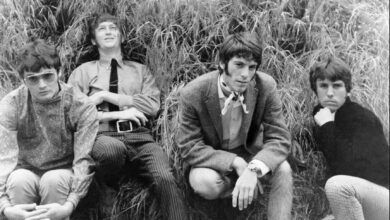Heart’s ‘These Dreams’ Captivates Audiences and Redefines Their Sound in 1986
In 1986, These Dreams became a defining moment for Heart, marking the band’s first-ever No. 1 hit on the Billboard Hot 100. This dreamy, atmospheric ballad signaled a stylistic shift for the rock-driven band, showcasing a softer, more introspective sound. Released as the third single from their self-titled album Heart (1985), the song resonated deeply with audiences, thanks to its ethereal melodies, poetic lyrics, and an emotional vocal performance by Nancy Wilson. Not only did These Dreams climb to the top of the charts, but it also helped revitalize Heart’s career, introducing them to a new generation of listeners.
Heart was already an established force in rock music by the mid-1980s. Led by sisters Ann and Nancy Wilson, the band had made a name for themselves in the 1970s with powerhouse rock anthems like Barracuda and Magic Man. Their ability to blend hard rock energy with folk and acoustic influences set them apart from their contemporaries. However, by the early ‘80s, Heart’s commercial success had begun to wane. Their transition to Capitol Records and the release of Heart in 1985 marked a deliberate reinvention, incorporating more polished production and radio-friendly ballads that would define their resurgence.
Interestingly, These Dreams was not originally written for Heart. The song was penned by songwriting duo Martin Page and Bernie Taupin—the latter being best known for his legendary collaborations with Elton John. Taupin’s lyrics were inspired by a romanticized dreamscape, filled with vivid, surreal imagery, and reflections on love and longing. When the song was presented to Heart, it became the perfect fit for Nancy Wilson, who had long desired a lead vocal feature to showcase a more personal side of her artistry.
The recording of These Dreams introduced a new sonic texture to Heart’s repertoire. Produced by Ron Nevison, the song featured shimmering synthesizers, lush reverb-laden guitars, and a gentle, almost whispered vocal delivery from Nancy Wilson. What made her performance particularly unique was the fact that she was battling a cold during the recording. This unexpected circumstance resulted in a slightly raspy, breathy quality to her vocals—an element that added to the song’s haunting and dreamlike atmosphere. The softer vocal approach contrasted with Ann Wilson’s signature powerhouse style, providing a fresh dynamic that helped These Dreams stand out.
Upon its release as a single in January 1986, These Dreams quickly gained traction. It climbed the Billboard Hot 100 and reached No. 1 on March 22, 1986, marking a milestone in Heart’s career. The song also performed well on the Adult Contemporary charts, further expanding their audience. The unexpected success of These Dreams proved that Heart could thrive in the evolving landscape of 1980s rock, where power ballads and polished production were becoming increasingly dominant.
Beyond its chart success, These Dreams played a crucial role in reshaping Heart’s public image. Previously known for their raw, guitar-driven rock anthems, the song helped showcase their versatility, proving that they could deliver emotionally resonant ballads just as effectively. The track’s introspective lyrics and ethereal production aligned perfectly with the growing trend of deeply personal, dreamlike storytelling in pop and rock music.
For Heart, These Dreams opened up new creative and commercial opportunities. The success of the song, along with other hits from the Heart album like What About Love and Never, propelled the band to new heights. They embarked on sold-out tours, gained heavy rotation on MTV, and cemented themselves as one of the leading acts of the mid-‘80s rock resurgence. The song also allowed Nancy Wilson to step further into the spotlight, proving that she was not only a skilled guitarist but also a compelling lead vocalist.
The influence of These Dreams extended beyond Heart’s career, helping to shape the evolving landscape of rock and pop balladry. Many artists in the late 1980s and early 1990s embraced a similar blend of atmospheric production and emotional storytelling, evident in the work of bands like Mr. Mister, Starship, and even later power ballads from Bon Jovi and Aerosmith.
Over the years, These Dreams has remained one of Heart’s most beloved songs and has been covered by various artists. While no version has matched the success of the original, its dreamlike quality and poetic lyricism have made it a favorite for reinterpretation. Nancy Wilson, in particular, has continued to perform the song in solo acoustic sets, keeping its legacy alive for devoted fans.
At the time of These Dreams’ release, Heart was experiencing a renaissance in their career. The success of the song, along with their other mid-‘80s hits, reinvigorated their standing in the music industry. Though the band would go through further stylistic shifts in the years to come, These Dreams remained a pivotal turning point, proving that reinvention could lead to even greater heights.
Decades later, These Dreams continues to be a staple on classic rock and adult contemporary radio stations. Its enduring appeal lies in its evocative lyrics, haunting melody, and the heartfelt performance by Nancy Wilson. Fans often cite it as one of the band’s most emotional and intimate tracks, a song that captures the delicate balance between longing and hope.
Looking back, These Dreams was more than just a No. 1 hit—it was a testament to Heart’s adaptability and artistic range. It showcased their ability to evolve with the times while staying true to their emotional core. In a decade filled with bombastic rock anthems and larger-than-life personas, These Dreams stood out for its quiet intensity and ethereal beauty, ensuring its place in music history as one of the most unforgettable ballads of the 1980s.



